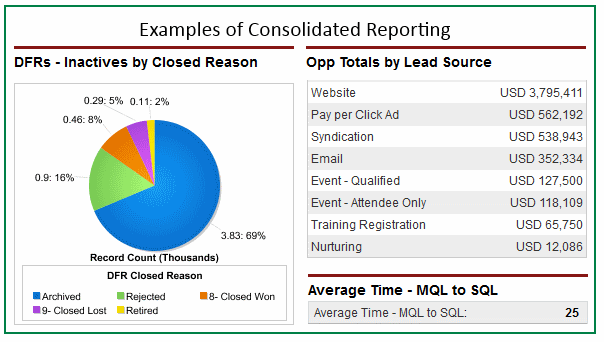Let’s talk about the demand funnel. Are you getting the most out of having implemented a demand funnel in your organization, in terms of knowledge that adds value to your marketing efforts? If you’d like to get more insight from your demand funnel, here are some key points to consider.
How many MQLs do you really have?
Theoretically, a lead can become marketing qualified (an MQL) multiple times. An MQL could sit in the queue for a long time and stagnate, or Sales could reject it and push to Remarket or Recycle status. To keep track of that person in your funnel, have you defined what happens if, for example, that lead reactivates through a Recycle nurture, and gets created as an MQL again?
In Salesforce, out of the box, there is no default way to track that situation and see how many times a lead moves through the funnel or has been through the sales cycle. To resolve this issue with some of our clients, DemandGen created demand funnel reporting that tracks every time a lead enters the demand funnel, and its current stage at any given time. You can reap great rewards from knowing this information—but building an effective demand funnel reporting solution is somewhat complex, and involves various factors. One, for example, is data storage. How much volume do you want to track, and how many records do you want to store? In theory you could start tracking the demand funnel at the very top, or choose to track only when data becomes more relevant to the sales cycle in terms of an MQL.
How long are leads in the funnel?
Salesforce data is all about leads, so you can easily see the “age” (number of days since created date) of a lead. But you can’t see by default how long this lead has been in its current stage of the funnel, or how long it took to move through each of the previous stages. This visibility can, however, be accomplished through custom fields and triggers featured in a robust demand funnel reporting solution built within Salesforce.com. You want to look at the the trigger points in the demand funnel: the key steps where, for example, a lead gets converted to a contact. Often, that’s considered a Sales Accepted Lead (SAL). But if it’s converted to a contact and an opportunity, that is obviously a Sales Qualified Lead (SQL). If an MQL is converted to an SAL by changing it to a contact, but it is never created as an opportunity–how do you track and manage that? These are some of the points you need to think through in order to measure your funnel throughput.
What drives leads through the funnel?
If we’re looking at marketing campaigns to which a lead responded–most recent campaign, most recent lead source, most recent channel or offer–we can effectively monitor the history of those indicators and correlate them to significant changes in funnel status.. We can essentially take a snapshot of the moment that a lead became a MQL, SAL, or SQL to see the last action the prospect took before conversion.
But this isn’t just of academic interest! At DemandGen, we create a flat file view with data like lead, contact, opportunity, and account, and place it all on one object: allowing us to compare that data easily without having to cross-reference objects within Salesforce. For example, by tying this information to data that includes the average number of days from one stage to the next by lead source, you’re able to determine the best lead sources that are driving sales quickly through the funnel. You can compare velocity by lead source to velocity by offer or channel. You could look at Sales versus Marketing activity on a contact.
What actions result in the creation of Opportunities?
Through aggregating all this historical data in Salesforce and pushing it to one object for reporting, we’re able to track much longer timelines than just a lead converted to opportunity in Salesforce. We can track the entire history of a lead and pull it forward to see how how the opportunity was influenced. You can see which actions may have caused a lead to advance to the next stage. Taken one lead at a time, some of the data tracked and analyzed could stem from coincidence, or be not significant for other reasons, but with larger amounts of data, you’re able to recognize trends that are meaningful. Companies of every size can benefit from this kind of business intelligence.
How do you unify the view?
What do you do, once you have a good process in place for collecting and consolidating all this information? The key is a consolidated reporting format in Salesforce that can communicate the value created by your lead sources, channels, and offers. The value of this solution stems from knowing, specifically, what Marketing or Sales actions are resulting in changes in the stage, and causing the fastest velocity through the funnel. So you want to make sure that you create reporting out of this solution that specifically highlights these points. Here are a few examples:
Real ROI: closed-loop reporting
With a consolidated reporting format, you can get real ROI: the closed-loop reporting that is the “Holy Grail” of Sales and Marketing.
Interested in knowing more about how to build sophisticated demand funnel reporting? We’d love to talk with you; to schedule a call, just drop a note to our Business Development team.
 Drew Noel is a highly experienced consultant in marketing automation, revenue performance management, and CRM integration project management. As a DemandGen Account Director, he provides expertise in ongoing best practices around demand generation, campaign execution, and ways for DemandGen clients to better leverage marketing automation to achieve their goals.
Drew Noel is a highly experienced consultant in marketing automation, revenue performance management, and CRM integration project management. As a DemandGen Account Director, he provides expertise in ongoing best practices around demand generation, campaign execution, and ways for DemandGen clients to better leverage marketing automation to achieve their goals.
The post Using Salesforce.com to Track Demand Funnel Volume and Velocity appeared first on DemandGen.












